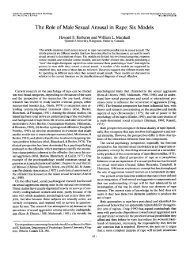Regulation of the dopamine transporter - Addiction Research ...
Regulation of the dopamine transporter - Addiction Research ...
Regulation of the dopamine transporter - Addiction Research ...
Create successful ePaper yourself
Turn your PDF publications into a flip-book with our unique Google optimized e-Paper software.
Schmitt & Reith DAT <strong>Regulation</strong><br />
phosphorylation by using small-molecule inhibitors<br />
<strong>of</strong> MEK affects DAT function and trafficking similarly<br />
to PI3K inhibition, decreasing <strong>the</strong> V max <strong>of</strong><br />
<strong>dopamine</strong> uptake without altering <strong>the</strong> Km and<br />
inducing cytosolic redistribution <strong>of</strong> plasmalemmal<br />
DAT into endosomal compartments. 78,81 The<br />
MAPK and PI3K signaling cascades are probably<br />
involved in <strong>the</strong> regulation <strong>of</strong> DAT activity by various<br />
classes <strong>of</strong> transmembrane receptors, such as<br />
GPCRs (discussed in <strong>the</strong> following section) and receptor<br />
tyrosine kinases. For example, in addition<br />
to insulin—which has been shown to increase plasmalemmal<br />
DAT function—activation <strong>of</strong> <strong>the</strong> neurotrophin<br />
receptor tyrosine kinase TrkB with brainderived<br />
neurotrophic factor also upregulates DAT<br />
activity, an effect that hinges on both <strong>the</strong> MAPK and<br />
PI3K pathways. 52 MAPK family members ERK1 and<br />
ERK2 have also been implicated in cocaine addiction<br />
and relapse after cocaine withdrawal, as central<br />
mediators <strong>of</strong> long-term sensitization to cocaine associated<br />
cues (for review, see Lu et al. 82 ).<br />
Ubiquitination and o<strong>the</strong>r direct<br />
posttranslational modifications<br />
Covalent attachment <strong>of</strong> <strong>the</strong> small soluble protein<br />
ubiquitin to <strong>the</strong> ε-amino moiety <strong>of</strong> lysine residues<br />
in target cellular proteins is known as ubiquitination.<br />
The ubiquitination reaction is catalyzed by a<br />
multistep enzymatic system, with <strong>the</strong> final covalent<br />
attachment mediated by members <strong>of</strong> a family <strong>of</strong> proteins<br />
known as E3 ubiquitin ligases (<strong>the</strong> multifarious<br />
functions <strong>of</strong> ubiquitin are reviewed in Welchman<br />
et al. 83 ). The most widely recognized function <strong>of</strong><br />
ubiquitination is polyubiquitination, which occurs<br />
when several ubiquitin subunits are attached to one<br />
lysine, forming a chain. Polyubiquitin chains serve<br />
as a signaling motif, indicating that a target protein<br />
is to be trafficked to <strong>the</strong> 26S proteasome for proteolytic<br />
destruction. However, attachment <strong>of</strong> one<br />
ubiquitin subunit to a target protein (monoubiquitination)<br />
is also a signaling motif and is thought<br />
to encourage retention <strong>of</strong> target proteins in sorting<br />
endosomes for eventual trafficking to <strong>the</strong> lysosomal<br />
degradation pathway. 84 Ubiquitination can<br />
fulfill roles o<strong>the</strong>r than those directly serving protein<br />
breakdown. For example, ubiquitination <strong>of</strong> <strong>the</strong><br />
yeast �-factor receptor Ste2 promotes endocytosis<br />
<strong>of</strong> <strong>the</strong> receptor–ligand complex prior to degradation<br />
in <strong>the</strong> vacuole. 85 The yeast multidrug <strong>transporter</strong><br />
Pdr5, 86 and <strong>the</strong> Ste6 �-factor pheromone<br />
<strong>transporter</strong>, 87 both members <strong>of</strong> <strong>the</strong> ATP-binding<br />
cassette multidrug <strong>transporter</strong> family, appear to be<br />
prepared by ubiquitination for endocytic delivery to<br />
<strong>the</strong> vacuole for proteolytic turnover. In <strong>the</strong>se cases,<br />
ubiquitination may serve as a signal for protein trafficking<br />
ra<strong>the</strong>r than a signal for protein degradation<br />
itself. Work by Hicke’s group 88 has provided<br />
more information on ubiquitin as a signal for endocytosis<br />
<strong>of</strong> <strong>the</strong> plasma membrane protein Ste2p,<br />
<strong>the</strong> mating pheromone �-factor receptor. Unlike<br />
<strong>the</strong> ubiquitin proteasome recognition signal, <strong>the</strong><br />
internalization signal does not require polyubiquitin<br />
formation through Lys-18 but ra<strong>the</strong>r relies on<br />
monoubiquitination <strong>of</strong> one lysine residue <strong>of</strong> <strong>the</strong><br />
Ste2p.<br />
There is evidence that, like phosphorylation,<br />
ubiquitination <strong>of</strong> <strong>the</strong> DAT affects cell surface expression<br />
and membrane trafficking <strong>of</strong> <strong>the</strong> <strong>transporter</strong>.<br />
Interestingly, many <strong>of</strong> <strong>the</strong> same intracellular signaling<br />
kinases involved in DAT phosphorylation may<br />
also be responsible for signaling via ubiquitination.<br />
For example, Miranda et al. demonstrated that activation<br />
<strong>of</strong> PKC by treatment with �-PMA increases<br />
ubiquitination <strong>of</strong> <strong>the</strong> DAT and that <strong>the</strong> major proportion<br />
<strong>of</strong> ubiquitin-conjugated DAT was present<br />
as <strong>the</strong> monoubiquitinated species. 89 Using Förster<br />
resonance energy transfer, <strong>the</strong> authors also showed<br />
that fluorescent-tagged hDAT and ubiquitin are associated<br />
in late endosomes and multivesicular bodies<br />
destined for lysosomal degradation. Much like<br />
PKC-associated <strong>transporter</strong> phosphorylation, ubiquitination<br />
<strong>of</strong> <strong>the</strong> DAT depends upon residues residing<br />
in <strong>the</strong> N terminus <strong>of</strong> <strong>the</strong> <strong>transporter</strong>, because<br />
simultaneous mutation <strong>of</strong> three amino-terminal lysine<br />
residues (Lys-19, Lys-27, and Lys-35) inhibits<br />
PKC-mediated ubiquitination. 90 Ubiquitin conjugation<br />
to <strong>the</strong> DAT is catalyzed by <strong>the</strong> ubiquitin ligase<br />
Nedd4-2. 91 Although it is clear that ubiquitination<br />
is involved in <strong>the</strong> regulated endocytosis <strong>of</strong> <strong>the</strong> DAT, a<br />
relationship between substrate-induced <strong>transporter</strong><br />
trafficking and ubiquitination has not yet been<br />
established.<br />
Presynaptic G protein-coupled receptors<br />
affecting DAT function<br />
Because DAT protein function and membrane distribution<br />
are acutely regulated via several different<br />
intracellular signaling cascades, it is not surprising<br />
that activation <strong>of</strong> various types <strong>of</strong> GPCRs expressed<br />
Ann. N.Y. Acad. Sci. 1187 (2010) 316–340 c○ 2010 New York Academy <strong>of</strong> Sciences. 325










